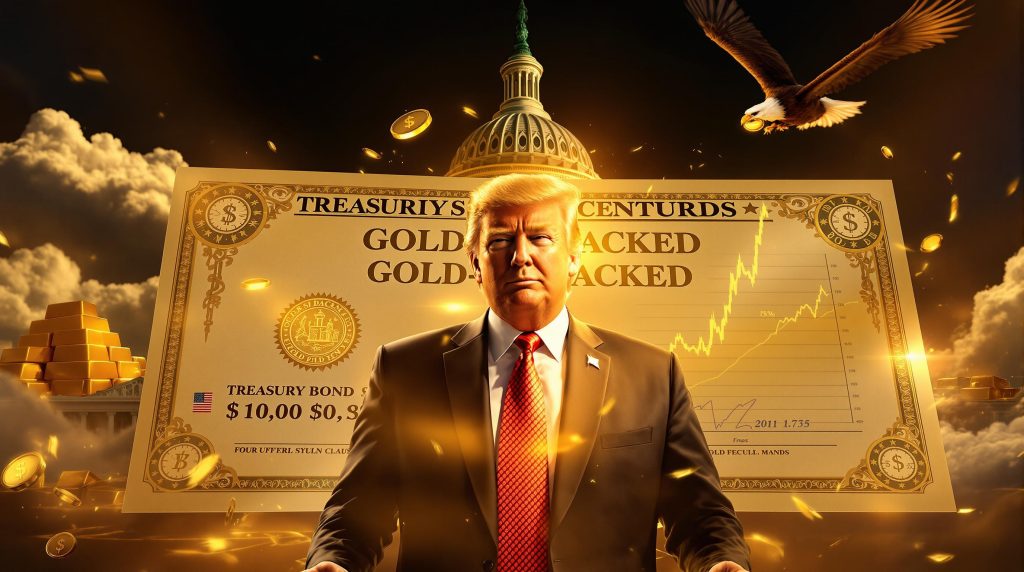What Are Gold-Backed Treasuries and Why Are They Significant?
Gold-backed treasuries represent government debt instruments secured by physical gold reserves. Unlike conventional treasury bonds that rely solely on government promises, these securities would be redeemable in physical gold at a specified rate. This connection to a tangible asset provides an inflation hedge and potentially restores confidence in government debt during periods of economic uncertainty.
The significance of gold-backed treasuries extends beyond their structure. They represent a partial return to sound money principles abandoned with the end of the Bretton Woods system. They could fundamentally alter global reserve currency dynamics, serve as a counterbalance to emerging alternative financial systems, and potentially address the growing U.S. debt crisis through monetary restructuring.
Gold-backed treasuries would mark a significant departure from the purely fiat currency system that has been in place since 1971, potentially reintroducing a tangible asset foundation to at least part of the monetary system. This hybrid approach aims to combine the stability of gold with the flexibility of modern monetary policy.
Historical Context of Gold-Backed Currency in the U.S.
The United States has a complex history with gold-backed monetary instruments that provides important context for current discussions:
- 1900-1933: The Gold Standard Act established gold as the only standard for redeeming paper money, creating a direct link between currency and gold reserves
- 1933-1971: The gold exchange standard limited gold convertibility to foreign governments and central banks, following Executive Order 6102 which prohibited private gold ownership by U.S. citizens
- August 15, 1971: President Nixon ended the convertibility of the dollar to gold, creating the current fiat system in what became known as the "Nixon Shock"
- 1974: Restrictions on American private gold ownership were lifted, allowing citizens to once again legally own gold bullion
- 1980s-Present: Periodic calls for returning to gold-backed currency have emerged during economic crises, particularly after the 2008 financial crisis
This historical progression shows how the U.S. moved from direct gold backing to the current system where the dollar's value is primarily based on economic output and global confidence. The official price of gold on government books remains at $42.22 per ounce, despite market prices above $3,000, creating a significant accounting discrepancy.
Why Would Trump Consider Issuing Gold-Backed Treasuries?
The concept of Trump issuing gold-backed treasuries has gained attention among monetary policy analysts and precious metals investors. While no official policy announcements have confirmed such plans, several economic and geopolitical factors make this scenario worth exploring.
Economic Motivations for Gold-Backed Securities
Several economic factors might motivate the potential issuance of gold-backed treasuries:
- Addressing the Debt Crisis: With significant treasury maturities approaching and projected tax revenue insufficient to cover them, alternative financing mechanisms become necessary
- Combating Inflation: Gold-backed securities could help stabilize purchasing power amid expansionary monetary policy that has expanded the money supply
- Manufacturing Resurgence: A potentially revalued dollar resulting from gold repricing could make American exports more competitive globally
- Reducing Borrowing Costs: Zero-coupon gold-backed bonds could dramatically lower long-term government financing costs compared to interest-bearing securities
- Addressing Triffin's Dilemma: The conflict between domestic and international monetary policy objectives that affects reserve currency nations
The Triffin Dilemma remains particularly relevant—the conflict between a reserve currency country's national interest and its international responsibilities. The U.S. must maintain a strong dollar for domestic purposes while also providing sufficient liquidity to the global system, which requires running persistent deficits.
Geopolitical Considerations in a Changing Global Order
The geopolitical landscape presents additional motivations for considering gold-backed treasuries:
- BRICS Expansion: The growing economic bloc has openly discussed gold-backed settlement mechanisms at recent summits
- De-dollarization Trends: Many nations are reducing dollar reserves and increasing global gold reserves—central banks purchased record amounts of gold in recent years
- Economic Sovereignty: Reduced dependence on international financial systems controlled by potential adversaries
- Trade Rebalancing: Addressing persistent trade deficits through currency realignment
- Manufacturing Security: Ensuring domestic production capacity for critical goods and technologies
Recent tariff policies and trade negotiations already reflect concerns about manufacturing capacity and trade imbalances. A monetary component could complement these existing policy directions by addressing the currency valuation aspects of trade competitiveness.
How Would Gold-Backed Treasuries Actually Work?
The implementation of gold-backed treasuries would require careful planning and execution to avoid market disruption while achieving the desired economic effects.
Potential Structure and Implementation Timeline
If implemented, gold-backed treasuries might follow this structure:
- Dual Treasury System: Short-term treasuries (1-2 years) could continue to be funded through traditional markets; long-term treasuries would be backed by gold
- Redemption Mechanism: Long-term treasuries would be redeemable for physical gold at a predetermined rate after holding periods
- Zero-Coupon Structure: Bonds would likely pay no interest, with returns coming solely from gold price appreciation
- Gradual Implementation: A phased approach beginning with a portion of new issuances rather than immediate conversion of all outstanding debt would reduce market disruption
- Legal Framework: Legislative authorization would be required, likely involving amendments to the Federal Reserve Act and Treasury regulations
The implementation would need to balance immediate economic needs with long-term monetary stability goals. A gradual approach would allow markets to adjust while maintaining essential government funding capabilities.
Gold Revaluation and Its Economic Implications
A critical component would involve gold revaluation:
- Current Official Price: Gold remains officially valued at $42.22 per ounce on government books, despite historic gold highs above $3,000
- Revaluation Mechanism: The Treasury's Gold Revaluation Account would need to recognize market-based pricing
- Balance Sheet Impact: Significant gold revaluation would substantially increase Treasury assets
- Currency Effects: Gold revaluation would likely impact the dollar's exchange rate against other currencies
- Purchasing Power Shift: Essential goods might become more expensive in dollar terms, while U.S. exports become more competitive
The gap between the official gold price ($42.22) and market prices represents a substantial unrealized accounting asset on the government's balance sheet. Recognizing this value could significantly alter the government's financial position.
What Are the Potential Economic Consequences?
The introduction of gold-backed treasuries would create far-reaching economic effects that would transform both domestic and international financial systems.
Domestic Economic Effects
The introduction of gold-backed treasuries would create far-reaching domestic economic effects:
- Manufacturing Renaissance: A repriced dollar could accelerate reshoring of manufacturing operations, particularly in strategic industries
- Investment Patterns: A shift from speculative assets toward productive capacity and tangible assets would likely occur
- Wealth Distribution: Those holding primarily financial assets might experience relative losses compared to those with tangible assets
- Interest Rate Dynamics: A possible bifurcation between gold-backed (low/zero rate) and conventional treasuries could create a two-tier interest rate environment
- Banking System Changes: Financial institutions would need to adapt to a partially gold-backed monetary system
The transition period would likely involve significant market volatility as asset prices adjust to the new monetary framework. Historical transitions between monetary systems have typically created both winners and losers as relative valuations shift.
Disclaimer: The economic projections discussed here are speculative and based on theoretical models. Actual outcomes would depend on implementation details, market reactions, and concurrent policy decisions.
Global Financial System Impacts
Internationally, the effects could be equally significant:
- Reserve Currency Status: Potential strengthening of the dollar's reserve status through enhanced credibility and stability
- Gold Market Dynamics: Dramatic increase in institutional and central bank demand for physical gold
- Alternative Financial Systems: Acceleration or modification of competing systems like those being developed by BRICS nations
- International Trade Patterns: Realignment of global trade flows based on new currency valuations
- Commodity Markets: Repricing of dollar-denominated commodities relative to gold
A gold component in the treasury market could significantly alter central bank reserve management globally. Nations with substantial U.S. treasury holdings would need to reassess their positions and potentially adjust their gold allocations.
How Does This Relate to Global Financial Trends?
The potential introduction of gold-backed treasuries would not occur in isolation but against a backdrop of significant changes in the global financial architecture.
Comparison to BRICS Financial Initiatives
The BRICS economic bloc has been developing alternative financial structures:
- Cross-Border Payment Systems: Alternative payment systems connect multiple countries outside the traditional SWIFT network
- Settlement Timeframes: Alternative systems reportedly settle transactions much faster than traditional banking systems
- Fee Structure: Alternative payment systems claim to offer reduced transaction fees compared to conventional systems
- Gold Settlement: Some countries have begun exploring using physical gold to settle trade imbalances
- Expanding Participation: Financial cooperation has expanded beyond core BRICS members to include other nations
These developments represent attempts to create alternative financial architectures that reduce dependence on dollar-based systems. Gold-backed treasuries could be seen as a competitive response to maintain the dollar's dominant position.
The Role of Stable Coins in Government Finance
Stable coins represent another crucial element in this financial evolution:
- Treasury Funding: Potential use of stable coins to fund short-term government operations
- Banking Integration: Major financial institutions increasingly connecting traditional banking with digital asset platforms
- Regulatory Framework: Legislative efforts to provide legal structure for stable coin issuance and usage
- Transaction Efficiency: Digital assets offer reduced settlement times and costs compared to traditional systems
- Corporate Adoption: Major corporations exploring stable coin issuance backed by treasury securities
The convergence of traditional government finance with digital asset technology creates opportunities for innovative funding mechanisms. Gold-backed treasuries could potentially leverage both physical gold backing and digital distribution channels.
What Are the Potential Obstacles to Implementation?
Despite potential benefits, introducing gold-backed treasuries would face significant challenges that would need to be addressed for successful implementation.
Technical and Logistical Challenges
Several practical hurdles would need to be overcome:
- Gold Verification and Storage: Ensuring adequate audited physical gold reserves to maintain credibility
- Market Transition: Managing the shift without creating excessive volatility or disruption
- Legal Framework: Establishing the necessary legislative and regulatory foundation
- International Coordination: Engaging with allies and trading partners to minimize disruptive effects
- Technological Infrastructure: Developing secure systems for redemption and verification
The physical logistics of gold management at scale present significant challenges. Current vault facilities, auditing procedures, and security protocols would need substantial enhancement to support a gold-backed treasury system with credibility.
Political and Institutional Resistance
Significant opposition could emerge from various quarters:
- Central Banking Establishment: Potential resistance to reduced monetary policy flexibility
- International Organizations: IMF and similar institutions might oppose fundamental changes to the dollar system
- Domestic Political Opposition: Concerns about inflation, economic disruption, or wealth redistribution
- Financial Industry: Resistance from sectors benefiting from the current monetary arrangement
- Foreign Governments: Nations heavily invested in dollar assets might oppose changes affecting their value
Any significant monetary reform would require navigating complex institutional and political interests. The Federal Reserve's independence, Treasury Department authority, and Congressional oversight create multiple layers of governance that would need alignment for successful implementation.
How Might This Affect Individual Investors?
The introduction of gold-backed treasuries would significantly alter the investment landscape, requiring strategic adjustments from individual investors.
Investment Strategy Considerations
Investors would need to reconsider their approaches:
- Precious Metals Allocation: Increased importance of physical gold and silver as monetary assets
- Treasury Investment: Different risk-reward profiles for conventional versus gold-backed treasuries
- Equity Markets: Potential sector rotation favoring manufacturing, commodities, and tangible asset producers
- Real Estate: Possible repricing based on new monetary dynamics and interest rate environment
- Retirement Planning: Need for diversification across both conventional and new monetary systems
Investors with longer time horizons might benefit from increased allocation to sectors likely to benefit from a manufacturing renaissance and commodity revaluation. Defensive sectors with limited pricing power might face challenges during the transition period.
Protecting Purchasing Power in a Transitional Period
During any transition, preserving wealth would be paramount:
- Physical Asset Ownership: Direct ownership of precious metals without counterparty risk provides foundational security
- Essential Productive Assets: Investments in food production, energy, and critical manufacturing
- Skills Development: Personal capabilities that retain value regardless of monetary system
- Community Resilience: Local economic networks less dependent on global financial systems
- Debt Management: Strategic positioning regarding fixed-rate long-term debt versus liquid assets
Maintaining optionality through diverse asset classes would be critical during any significant monetary transition. Historical monetary system changes have often created unexpected winners and losers as relative asset values adjust.
What Are the Historical Precedents for Such a Move?
Understanding previous monetary transitions provides valuable context for evaluating the potential implementation and effects of gold-backed treasuries.
Previous Gold Standard Transitions
History provides several relevant examples:
- 1944 Bretton Woods Establishment: Creation of the post-WWII monetary order based on gold-backed dollars at $35 per ounce
- 1971 Nixon Shock: Unilateral end to dollar-gold convertibility and its global economic consequences
- 1980s Volcker Era: High interest rates to restore confidence without returning to gold backing
- Post-2008 Global Financial Crisis: Quantitative easing as an alternative to fundamental monetary reform
- European Monetary System Transitions: Various European attempts at currency stabilization mechanisms
The 1971 Nixon Shock provides particularly relevant insights. Initially intended as a temporary measure, the suspension of gold convertibility became permanent and fundamentally altered the global monetary system. This demonstrates how transitional monetary policies can become entrenched.
Lessons from International Monetary Reforms
Other countries' experiences offer valuable insights:
- Switzerland's Historical Gold Backing: Long-term economic stability through partial gold reserves
- China's Gradual Internationalization: Methodical approach to currency reforms and gold accumulation
- Russia's De-dollarization Strategy: Systematic reduction of dollar exposure and increase in gold reserves
- Post-Soviet Economic Transitions: Challenges of currency reforms during economic restructuring
- Latin American Currency Stabilization Efforts: Successes and failures in addressing hyperinflation
These examples highlight the importance of careful planning and graduated implementation. Abrupt monetary transitions have historically created significant economic disruption, while gradual approaches have typically proven more successful at maintaining stability.
What Are the Signs This Might Actually Happen?
While speculation about gold-backed treasuries remains theoretical, certain market and policy developments could indicate increased probability of such a shift.
Current Market Indicators
Several market developments might suggest potential preparation:
- Physical Gold Flows: Significant movements of physical gold between global markets and storage centers
- Delivery Patterns: Changing patterns in physical delivery requests on futures contracts
- Premium Structures: Variations in premiums for immediate physical delivery versus futures contracts
- Central Bank Positioning: Continued central bank gold purchases globally
- Insider Activity: Divergence between retail and institutional investor behavior in equity markets
Unusual movements in physical gold markets can provide early signals of changing monetary conditions. Increased preference for physical delivery over cash settlement in futures markets may indicate growing concerns about counterparty risk.
Official Statements and Policy Directions
Public communications also provide potential clues:
- Treasury Department Comments: References to monetizing assets on the government balance sheet
- Federal Reserve Nominee Positions: Views of potential appointees regarding monetary policy
- Legislative Developments: Regulatory frameworks advancing through Congress
- Trade Policy Actions: Tariff structures potentially preparing for manufacturing reshoring
- International Monetary Discussions: Changing rhetoric around the dollar's global role
Official policy statements rarely telegraph major monetary changes directly, but close analysis of terminology shifts and policy emphases can provide insights into potential direction. Historical monetary transitions have often been preceded by subtle changes in official communications.
FAQ: Gold-Backed Treasuries and the U.S. Economy
Would gold-backed treasuries mean a return to the gold standard?
No, gold-backed treasuries would represent a partial return to gold-linked monetary instruments rather than a full gold standard. Unlike the historical gold standard where all currency was directly convertible to gold at a fixed rate, this approach would create a two-tier system with conventional treasuries continuing to operate alongside new gold-backed instruments. This hybrid approach would allow for greater monetary flexibility while still providing an inflation hedge through the gold-backed portion.
How might gold-backed treasuries affect everyday Americans?
The effects would likely include:
- Potential initial increase in prices for imported goods as the dollar adjusts
- Greater employment opportunities in domestic manufacturing sectors
- More stable long-term purchasing power for savings
- Changed investment landscape requiring new approaches to retirement planning
- Potentially lower borrowing costs for long-term projects like mortgages if tied to gold-backed rates
The transition period would likely create the most significant challenges, as markets adjust to new monetary conditions. However, once stabilized, a partial gold backing could provide greater long-term predictability in purchasing power.
What gold price would be needed to back U.S. debt obligations?
Estimates vary widely, but using the approach of dividing money supply by official gold reserves suggests prices significantly higher than current market levels. Some analysts suggest that meaningful backing for existing obligations would require gold prices many times current levels. However, partial backing at lower prices could still provide significant benefits while avoiding extreme economic disruption.
The calculation depends heavily on what percentage of debt would be backed and what measure of money supply is used (M1, M2, or broader definitions). A 100
Want to Capitalise on the Next Major Gold Discovery?
Stay ahead of the market with Discovery Alert's proprietary Discovery IQ model, which instantly notifies investors of significant ASX mineral discoveries, transforming complex gold data into actionable insights. Explore why major mineral discoveries can lead to substantial returns by visiting Discovery Alert's dedicated discoveries page and begin your 30-day free trial today.




